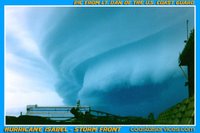By Robert P. King
Palm Beach Post Staff Writer
How many times do you need to hear this?
Get set for yet another harried hurricane season, Colorado State University researchers said Wednesday, because the one that begins today should be a doozy.
Prospects appear especially grim for Florida and the East Coast of the U.S., which stand a 69 percent chance of experiencing a major hurricane of at least Category 3 strength -- more than double the odds of an average year, they said.
That's one category stronger than Hurricane Wilma was Oct. 24, when it tossed railroad cars off their tracks in the Glades and left nearly 6 million people across South Florida without power.
The Gulf Coast, which took the brunt of Katrina, Rita and Dennis in 2005, has a 38 percent chance of another major hurricane strike this year, the scientists said. That's slightly higher than average.
Nobody can say for sure where the storms will strike, researchers Philip Klotzbach and William Gray cautioned. But key symptoms of the global climate point to a season in which hurricanes streaming west across the Atlantic will have a greater chance of striking land rather than curving harmlessly out to sea, they said.
Meanwhile, hurricane-friendly winds and warmer-than-average ocean temperatures, though not as scalding as last year, point to a bumper crop of hurricanes forming.
Wednesday's forecast comes a week after federal meteorologists issued a similar prediction for a busy season, calling on coastal residents to prepare for the worst. Public and private researchers on both sides of the Atlantic have issued similar prognostications in recent months.
In fact, the Colorado State scientists, who adjust their predictions every few months, haven't wavered since December in their forecasts for the number of tropical storms, hurricanes and major hurricanes.
They're calling for a total of 17 named storms, which would carry us all the way to Rafael.
That sounds a lot calmer than last year's record 28-storm season, which ventured into the Greek alphabet and ended with Zeta. Then again, 17 storms would be almost 80 percent more than the yearly average seen during the latter half of the 20th century.
Klotzbach and Gray's forecast includes nine hurricanes, compared with an average of 5.9, and five major hurricanes, compared with an average of 2.3.
"The conditions that we thought were likely to be present during the hurricane season still look like what we saw in the December hurricane forecast," Klotzbach said. "The Atlantic conditions haven't changed a whole lot."
Gray has been a pioneer in the tricky task of forecasting storm totals months in advance -- some years more successfully than others. (This time last year, he was predicting a mere 15 storms.)
Two years ago, he and Klotzbach started predicting the odds of storms hitting particular stretches of the coast, right down to the county.
Wednesday's forecast adds a new factor: the global atmospheric "steering currents" that can move storms toward or away from land.
Some of those relate to the Bermuda High, a zone of high pressure that squats on or near the southeastern U.S. coast in the summer and fall. Depending on where it sits, the high and its clockwise-swirling winds can steer hurricanes either onto land or into the North Atlantic.
In 2004, the high was so far west that it gave approaching storms no place to go but into Florida, contributing to our six-week spree of Charley, Frances, Ivan and Jeanne. Atmospheric patterns over the Northeast and Canada show the high may end up in a similar position this year, Klotzbach said.
Some meteorologists have tried to tie the Bermuda High's behavior to phenomena such as May rainfall in South Florida.
Others, such as National Hurricane Center Director Max Mayfield, have avoided making such prophecies.
"People are asking if the steering currents will stay the same, and the bottom line is nobody can tell you that," Mayfield said in April at the National Hurricane Conference in Orlando.
Klotzbach acknowledged that nothing about such forecasts is certain.
"It tells you something," he said. "You can't say what particular time or what particular town."
Among other details, Klotzbach and Gray said the portion of Florida's coast stretching from the Martin-St. Lucie county line to south of Naples has a 6 percent chance of feeling a major hurricane this year. The region also has a 1-in-4 chance of experiencing a hurricane of any strength, and a 76 percent chance of withstanding at least a tropical storm, they said.
All those numbers are more than twice the average.
